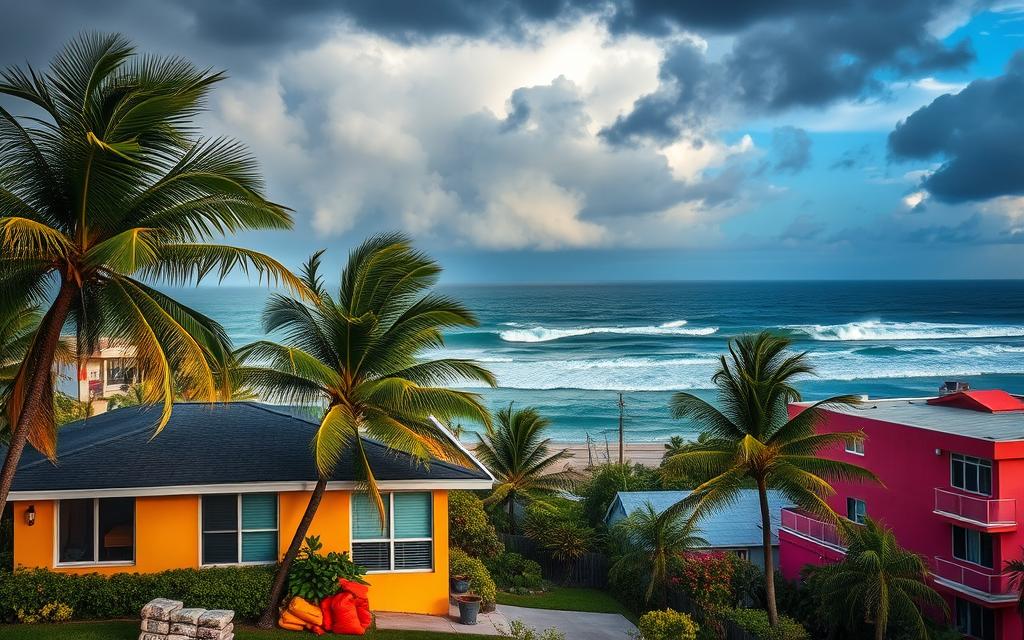Miami is one of the most hurricane-prone areas in the U.S. Hurricane season officially runs from June 1 to November 30. This period, especially mid-August to mid-October, requires careful preparation from everyone. It’s important to know the risks and how to stay safe.
Is Miami safe during hurricane season? This is a big question. Hurricanes can be very different, from Category 1 with 74 mph winds to Category 5 with over 156 mph winds. Miami’s Department of Emergency Management helps by teaching people about safety and emergency plans.
The Department makes sure everyone knows what to do during storms. They talk about emergency kits, evacuation routes, and the dangers of areas like the Everglades and the Atlantic Ocean. These are key to staying safe.
Miami has strong building codes and a culture of readiness. But, it’s also important for the community and government to work together. By staying informed and prepared, Miami can face hurricane seasons better.
Understanding Hurricane Season in Miami
Miami offers many benefits, but hurricane season poses a challenge. The city is lively, has stunning beaches, and a warm climate. Yet, many wonder if Miami is safe during this time. Keeping up with weather updates is key to staying safe.
What Months Does Hurricane Season Cover?
The Atlantic Hurricane Season runs from June 1 to November 30. This is nearly half the year. During these months, Miami residents must be alert as hurricane risk increases. The peak is in mid-August, so being ready early is crucial.
Storms can be severe, causing damage. Hurricanes are ranked from Tropical Depressions to Category 5. Knowing these rankings helps understand the storm’s power.
Common Hurricanes that Impact Miami
Miami has faced many hurricanes, like Hurricane Irma in 2017. In 2020, the Atlantic saw 30 named storms. This shows the season’s unpredictability.
It’s vital to watch for warnings from the National Hurricane Center. These alerts warn of high winds, heavy rain, and more. Having a solid emergency plan is essential.
Here are some key facts and statistics about hurricane categories and their potential impact:
| Category | Wind Speeds | Potential Damage |
|---|---|---|
| Tropical Depression | Up to 38 mph | Minimal |
| Tropical Storm | 39-73 mph | Moderate |
| Category 1 Hurricane | 74-95 mph | Very Dangerous |
| Category 2 Hurricane | 96-110 mph | Extremely Dangerous |
| Category 3 Hurricane | 111-129 mph | Devastating |
| Category 4 Hurricane | 130-156 mph | Catastrophic |
| Category 5 Hurricane | 157+ mph | Catastrophic |
Miami’s Geographic Advantage and Risks
Miami is near the Atlantic Ocean, making it a prime target for hurricanes. This situation highlights the need for good hurricane prep and knowing the area’s strengths and weaknesses.

Proximity to the Atlantic Ocean
Miami’s location near the Atlantic Ocean means it often faces hurricanes first. Coastal areas like Miami Beach are at higher risk for storm surges and flooding. So, these areas must take extra steps to stay safe during hurricane season.
Statistics show Miami, FL, has a 16% chance of a big hurricane each year. This high risk means residents must always update their hurricane prep plans. Services like Sparkly Maid Miami help make homes clean and safe before a storm hits.
The Role of the Everglades
The Everglades help protect Miami by absorbing hurricane impacts. But, it’s not foolproof. During strong hurricanes, the Everglades might not block all damage. So, having a solid prep plan is key.
To improve Miami’s hurricane readiness, focus on these steps:
- Family Emergency Plan: Create a plan for evacuations and staying in touch.
- Emergency Kits: Get all the necessary supplies.
- Staying Informed: Keep up with the National Hurricane Center’s updates.
- Home Protection: Use storm shutters or plywood to protect windows.
- Flood Insurance: Get insurance for homes in flood-risk areas.
| Area | Risk Level | Recommendations |
|---|---|---|
| Miami Beach | High | Elevate homes, install impact windows |
| Coral Gables | Moderate | Prepare emergency kits, regular home maintenance |
| Pinecrest | Moderate | Staying informed with forecasts |
Knowing Miami’s location and the Everglades’ role helps answer if Miami is safe during hurricane season. With careful prep and smart strategies, the community can face storms better.
Preparedness: How to Stay Safe in Miami
Being ready for hurricane season in Miami is key to staying safe. Having the right supplies and knowing evacuation routes is crucial. Here’s how to prepare well.
Emergency Kits and Supplies
Start by making an emergency kit. It should have water, food, medicine, and tools. Don’t forget a flashlight, extra batteries, and a phone charger for when the power goes out.
As a hurricane nears, Miami stores quickly sell out of these items. So, stock up early.
- Water (one gallon per person per day for at least three days)
- Non-perishable food (at least a three-day supply)
- Essential medications and a first-aid kit
- Battery-powered or hand-crank radio for updates
- Flashlight and extra batteries
- Portable phone charger
- Local maps and a whistle to signal for help
- Moist towelettes, garbage bags, and plastic ties for personal sanitation
Evacuation Routes and Plans
It’s important to know the hurricane evacuation routes in Miami and where hurricane shelters in Miami are. Miami-Dade County has Storm Surge Planning Zones A to E. Wolfson and Medical campuses of Miami Dade College are in Zone B, at risk for high storm surges.
Miami is split into evacuation zones based on flood risk. Knowing your zone is crucial. The local government has evacuation plans with routes and shelters. Follow these steps for a safe evacuation:
- Know your storm surge planning zone and stay updated on hurricanes.
- Listen to local authorities on when and where to evacuate.
- Use Miami-Dade County’s recommended evacuation routes.
- Go to the nearest hurricane shelter when told to do so.
- Don’t drive or walk through flooded areas.
By staying informed and following these tips, you can stay safe during a hurricane. For more help, check out the National Hurricane Center, Federal Emergency Management Agency, and Miami Dade County Emergency Management.
Government Resources for Hurricane Safety
When thinking about Is Miami safe during hurricane season, government resources are key. The city has many agencies focused on keeping people safe and ready for hurricanes.
Local Emergency Management Agencies
Miami’s Department of Emergency Management is crucial in disaster response. It helps reduce risks and damages from hurricanes. The department and Miami-Dade County’s Hurricane Website give lots of Miami hurricane emergency information on how to prepare and stay safe.
Many groups help with relief and recovery in Miami, like the American Red Cross, Catholic Charities, and Legal Services. Important numbers include Poison Control at 800-222-1222 and the Florida Division of Emergency Management at 850-815-4000.
The American Red Cross also helps with disaster kits and evacuation plans. Florida Power & Light Company gives tips on getting ready for power outages during hurricanes.

Importance of Staying Informed
It’s very important to stay updated during hurricane season. Miami-Dade County helps with evacuations and gives info on shelters and services. This helps people know the best steps to take when a storm is coming.
The JCS Helpline Services hotline at 305-576-6550 or 211 offers free help 24/7 after a storm. This network makes sure everyone has access to Miami hurricane emergency information. It helps keep the city safe during hurricane season.
| Storm Surge Zone | Risk Level |
|---|---|
| Zone A | Category 1 and higher |
| Zone B | Category 2 and higher |
| Zone C | Category 3 and higher |
| Zone D | Category 4 and higher |
| Zone E | Category 5 |
Community Response to Hurricanes
When hurricane season hits, Miami shows its strength and unity. Local groups and watches help keep everyone safe and ready. They play a big part in making Miami safe during hurricane season.
Neighborhood Watch and Support Groups
Neighborhood watches and support groups are key in Miami’s hurricane prep. They work together to protect homes, share resources, and stay updated. Regular meetings spread important info, making sure everyone is ready for hurricanes.
How Locals Prepare Together
Miami locals have a tradition of uniting during hurricane season. Community centers and local government host workshops on being ready. Topics include emergency kits, evacuation routes, and using government resources.
Organizations like the National Hurricane Center and FEMA help a lot. They offer the latest info and advice to these community efforts.
Here’s how Miami boosts its hurricane readiness:
| Preparation Activity | Details |
|---|---|
| Neighborhood Watch | Groups watch over each other’s properties, share updates, and provide mutual aid. |
| Support Groups | Locals form groups to distribute supplies, give emotional support, and assist in emergency plans. |
| Workshops and Training | Community-led sessions on emergency kits, evacuation plans, and staying informed. |
| Emergency Information Distribution | Timely updates from local authorities and national organizations like FEMA and NOAA. |
In conclusion, Miami’s community efforts make them ready for hurricane season. Neighborhood watches, support groups, and training answer the question, “Is Miami safe during hurricane season?” with a strong yes.
Post-Hurricane Recovery in Miami
Miami works hard to recover after hurricanes. They focus on cleaning up and making the city safer. Local authorities and community members are key to Miami’s quick recovery.
With the right resources and plans, Miami aims to get back to normal. They also prepare for future storms.
Cleanup Efforts and Resources
Removing debris is the first step in cleaning up after a hurricane. Residents should not pile debris in rear alleys. This makes cleanup easier.
Throwing away items that have been wet for too long helps prevent mold. Checking your home for damage, like gas leaks, is also important before going back inside.
The Miami-Dade County offers a Hurricane Readiness Guide. It helps residents prepare their homes for hurricane season. Safety tips for using chainsaws are also provided, stressing the importance of wearing proper gear.
Long-term Safety Improvements
Miami is always looking to improve its safety measures for future storms. If your property is damaged, contact the building department for an assessment. Knowing about permits is also crucial.
Controlling mosquito populations is important to prevent disease after a storm. This is especially true inside and outside homes.
Businesses get support to recover quickly after a disaster. Having access to generators is recommended. This helps reduce damage and speeds up recovery. Miami is confident and prepared for hurricane season.
Source Links
- https://www.visitflorida.org/resources/crisis-preparation/hurricane-information/frequently-asked-questions-on-travel-during-hurricane-season/
- https://www.city-data.com/forum/miami/582085-what-areas-safe-during-hurricane-season.html
- https://www.miamiandbeaches.com/weather-update
- https://www.wlrn.org/hurricane-coverage/2024-07-15/a-beginners-guide-to-hurricane-season-in-south-florida
- https://www.855dolor55.com/hurricane-guide/
- https://www.stateofflorida.com/articles/hurricane-preparedness-guide/
- https://www.sparklymaidmiami.com/blog/what-part-of-miami-is-safe-from-hurricanes
- https://www.paradiseexteriors.com/the-3-most-hurricane-prone-cities-in-florida/
- https://www.mdc.edu/safety/in-case-of-emergency/hurricane-preparedness/
- https://biscayneparkvillas.com/hurricane-tips-for-tourists-visiting-miami/
- https://unitedwaymiami.org/hurricane-resource-center/
- https://www.sibfl.gov/Public-Safety/Hurricane-Season-Resources
- https://prepare.miami.edu/before-emergency/hurricane-preparedness/index.html
- https://medium.com/usaid-2030/5-ways-usaid-is-preparing-for-hurricane-season-6b13f650ab03
- https://www.miami.gov/My-Government/Departments/Emergency-Management
- https://www.msvfl.gov/HurricanePreparedness
- https://www.miami.gov/My-Home-Neighborhood/Hurricane-Guide/After-a-Storm
- https://www.afar.com/magazine/should-you-travel-to-florida-in-hurricane-milton-aftermath

